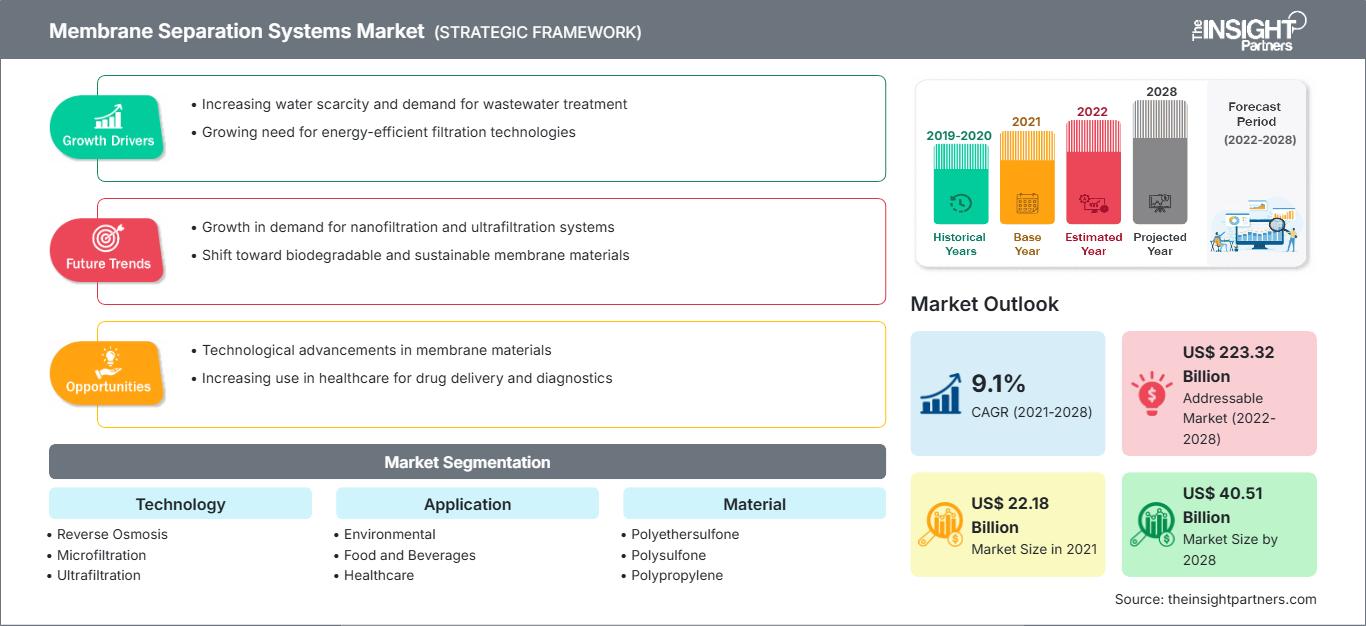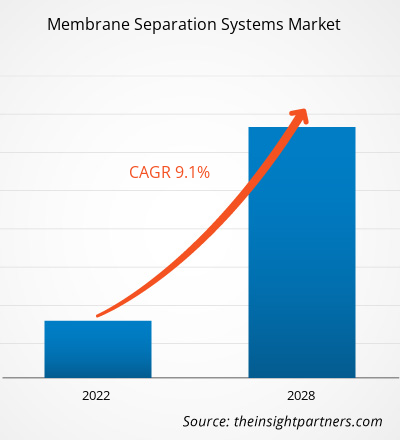Der Markt für Membrantrennsysteme wurde im Jahr 2021 auf 22.177,00 Millionen US-Dollar geschätzt; von 2022 bis 2028 wird ein durchschnittliches jährliches Wachstum von 9,1 % erwartet.
Membrantrennsysteme werden verwendet, um verschiedene Komponenten einer Lösung anhand ihrer Molekülgröße zu trennen. Umkehrosmose, Nanofiltration, Ultrafiltration und Mikrofiltration sind Membranfiltrationsverfahren, sortiert nach zunehmender Porengröße. Der weit verbreitete Einsatz von Membrantrennsystemen in der Abwasserbehandlung und ein breites Anwendungsspektrum in der Milchwirtschaft sind die wichtigsten treibenden Faktoren für das Marktwachstum. Die Komplexität der Membrantrenntechnik behindert jedoch das Marktwachstum.
Der Markt für Membrantrennsysteme wurde anhand von Technologie, Anwendung, Material und Geografie analysiert. Geografisch ist der Markt hauptsächlich in Nordamerika, Europa, den asiatisch-pazifischen Raum, den Nahen Osten und Afrika sowie Süd- und Mittelamerika unterteilt. Der Bericht bietet Einblicke und eine eingehende Analyse des Marktes für Membrantrennsysteme und legt dabei Wert auf Parameter wie Markttrends, technologische Fortschritte und Marktdynamik sowie die Analyse der Wettbewerbslandschaft führender Marktteilnehmer.
Passen Sie diesen Bericht Ihren Anforderungen an
Sie erhalten kostenlos Anpassungen an jedem Bericht, einschließlich Teilen dieses Berichts oder einer Analyse auf Länderebene, eines Excel-Datenpakets sowie tolle Angebote und Rabatte für Start-ups und Universitäten.
Markt für Membrantrennsysteme: Strategische Einblicke

- Holen Sie sich die wichtigsten Markttrends aus diesem Bericht.Dieses KOSTENLOSE Beispiel umfasst Datenanalysen, die von Markttrends bis hin zu Schätzungen und Prognosen reichen.
Sie erhalten kostenlos Anpassungen an jedem Bericht, einschließlich Teilen dieses Berichts oder einer Analyse auf Länderebene, eines Excel-Datenpakets sowie tolle Angebote und Rabatte für Start-ups und Universitäten.
Markt für Membrantrennsysteme: Strategische Einblicke

- Holen Sie sich die wichtigsten Markttrends aus diesem Bericht.Dieses KOSTENLOSE Beispiel umfasst Datenanalysen, die von Markttrends bis hin zu Schätzungen und Prognosen reichen.
Markteinblicke
Umfangreicher Einsatz in der Abwasserbehandlung treibt Marktwachstum für Membrantrennsysteme voran
Sauberes Wasser ist für das Überleben jedes Lebewesens unerlässlich. Aufgrund des rasanten Bevölkerungswachstums und der Industrialisierung steigt jedoch die Nachfrage nach sauberem, sicherem Trinkwasser rasant an. Die Wasserverschmutzung durch Schwermetalle, Cyanide und Farbstoffe nimmt weltweit zu. Membranverfahren wie Mikrofiltration (MF), Ultrafiltration (UF), Nanofiltration (NF) und Umkehrosmose (RO) werden häufig zur Filtration von Brack- und Meerwasser eingesetzt. Graphenoxidmembranen (GMs) zeigen vielversprechende Leistungen in Wasseraufbereitungsanwendungen wie Entsalzung und Abwasserbehandlung. GMs sollen aufgrund ihrer hydrophilen Eigenschaften, Flexibilität und hohen mechanischen Festigkeit einen breiten Bereich an reinem Wasserfluss ermöglichen, während UF- und NF-Membranen zur Reinigung von Abwasserströmen verwendet werden, die beim Spülen von Filterbetten in Schwimmbadwassersystemen anfallen. Die oben genannten Fakten führen zu einem zunehmenden Einsatz von Membrantrennsystemen in der Abwasserbehandlung und deuten somit auf eine steigende Nachfrage hin.
Membrananwendung
Technologiebasierte Erkenntnisse
Der Markt für Membrantrennsysteme ist technologisch in Mikrofiltration, Ultrafiltration, Nanofiltration, Umkehrosmose, Ionenaustausch und andere unterteilt. Das Segment Umkehrosmose hatte 2021 den größten Marktanteil und wird im Prognosezeitraum voraussichtlich auch die höchste durchschnittliche jährliche Wachstumsrate (CAGR) verzeichnen. Umkehrosmose bietet die feinste Filtrationsstufe in der Wasseraufbereitung. Die RO-Membran filtert alle Salze sowie anorganische und organische Moleküle mit einem Molekulargewicht über 100 kDa. Es handelt sich daher um ein hochwirksames Verfahren zur Entfernung von Verunreinigungen wie Endotoxinen/Pyrogenen, Insektiziden/Pestiziden, Herbiziden, Antibiotika, Nitraten, Zuckern, löslichen Salzen und Metallionen.
Anwendungsbasierte Erkenntnisse
Basierend auf der Anwendung ist der Markt für Membrantrennsysteme in die Bereiche Umwelt, Lebensmittel und Getränke, Gesundheitswesen und Sonstige unterteilt. Der Umweltbereich hatte 2021 den größten Marktanteil. Es wird jedoch erwartet, dass der Gesundheitsbereich im Prognosezeitraum die höchste durchschnittliche jährliche Wachstumsrate verzeichnet.
Materialbasierte Erkenntnisse
In Bezug auf das Material ist der Markt für Membrantrennsysteme in Polyethersulfone, Polysulfone, Polyvinylidenfluorid (PVDF), Polypropylen (PP), Polyacrylnitril (PAN) und Sonstige unterteilt. Das Segment Polyethersulfone hatte 2021 den größten Marktanteil und dürfte im Prognosezeitraum die höchste durchschnittliche jährliche Wachstumsrate (CAGR) verzeichnen.
Weltweit verlangsamten sich die Investitionen in neue Abwasseraufbereitungsanlagen in vielen Kleinst-, Klein- und Mittelbetrieben. Während der COVID-19-Pandemie kam es zu Umsatzrückgängen. Viele Unternehmen, die Wasser in großem Umfang nutzen, bauten ihre Aktivitäten ab oder reduzierten sie, was zu einem Rückgang der industriellen Wassernachfrage führte. Darüber hinaus bremsten Lockdowns und Reisebeschränkungen die Nachfrage großer Industrie- und Gewerbekunden zusätzlich. Diese Bedingungen führten zu einem Rückgang der Einnahmen der Wasserversorgungsunternehmen.
Unternehmen auf dem Markt für Membrantrennsysteme verfolgen häufig Produktneuheiten und Expansionsstrategien, um ihre Präsenz weltweit auszubauen und die wachsende Nachfrage zu decken. Ihr Fokus auf Produktinnovation ermöglicht es ihnen, auf die sich weltweit ändernden Kundenanforderungen einzugehen und so ihren Markennamen global zu wahren.
Im August 2022 gab Molnlycke, ein weltweit führendes Unternehmen für medizinische Produkte und Lösungen, zwei wegweisende Partnerschaften mit Engie und Veolia bekannt, die internationale Anbieter von Nachhaltigkeitslösungen sind. Das Unternehmen zielt darauf ab, für seine laufenden und kommenden Projekte erstklassige, energiesparende Abwasserbehandlungslösungen zu liefern, im Einklang mit seinem Ziel, ein nachhaltiges Produktionsökosystem im Gesundheitswesen aufzubauen und gleichzeitig die Marktanforderungen zu erfüllen.
Im Dezember 2020 brachte DuPont Water Solutions, eine Geschäftseinheit von DuPont Safety & Construction, TapTec Plus HF auf den indischen Markt. DuPont TapTec Plus ist mit allen Marken von Wasserreinigern für den Hausgebrauch kompatibel und eine ultimative Reinigungslösung für anspruchsvolle Verbraucher, die sauberes Haushaltswasser suchen und langfristig eine höhere Lebensqualität erreichen möchten.
Im April 2020 kündigte Koch Separation Solutions (KSS), ein weltweit führendes Unternehmen in der Membranfiltrations- und Ionenaustauschtechnologie, Pläne zur Erweiterung der Produktionskapazität seiner innovativen PURON-verstärkten Hohlfasermembrantechnologie um 50 % an. Diese Produktionserweiterung spiegelt das erhebliche Wachstum von KSS und seine verbesserte Fähigkeit wider, Unternehmen, die seine verstärkten Hohlfasermembrantechnologien für ihre industriellen und kommunalen Wasser- und Abwasseraufbereitungsanforderungen nutzen, schnell zu bedienen.
Geografisch ist der globale Markt für Membrantrennsysteme in Nordamerika (USA, Kanada und Mexiko), Europa (Frankreich, Deutschland, Großbritannien, Spanien, Italien und übriges Europa), Asien-Pazifik (China, Indien, Japan, Australien, Südkorea und übriger Asien-Pazifik-Raum), den Nahen Osten und Afrika (Saudi-Arabien, Vereinigte Arabische Emirate, Südafrika und der Rest von MEA) sowie Süd- und Mittelamerika (Brasilien, Argentinien und der Rest von Süd- und Mittelamerika).
MembrantrennsystemeRegionale Einblicke in den Markt für Membrantrennsysteme
Die Analysten von The Insight Partners haben die regionalen Trends und Faktoren, die den Markt für Membrantrennsysteme im Prognosezeitraum beeinflussen, ausführlich erläutert. In diesem Abschnitt werden auch die Marktsegmente und die geografische Lage von Membrantrennsystemen in Nordamerika, Europa, im asiatisch-pazifischen Raum, im Nahen Osten und Afrika sowie in Süd- und Mittelamerika erörtert.
Umfang des Marktberichts zu Membrantrennsystemen
| Berichtsattribut | Einzelheiten |
|---|---|
| Marktgröße in 2021 | US$ 22.18 Billion |
| Marktgröße nach 2028 | US$ 40.51 Billion |
| Globale CAGR (2021 - 2028) | 9.1% |
| Historische Daten | 2019-2020 |
| Prognosezeitraum | 2022-2028 |
| Abgedeckte Segmente |
By Technologie
|
| Abgedeckte Regionen und Länder | Nordamerika
|
| Marktführer und wichtige Unternehmensprofile |
|
Dichte der Marktteilnehmer für Membrantrennsysteme: Verständnis ihrer Auswirkungen auf die Geschäftsdynamik
Der Markt für Membrantrennsysteme wächst rasant. Die steigende Nachfrage der Endverbraucher ist auf Faktoren wie veränderte Verbraucherpräferenzen, technologische Fortschritte und ein stärkeres Bewusstsein für die Produktvorteile zurückzuführen. Mit der steigenden Nachfrage erweitern Unternehmen ihr Angebot, entwickeln Innovationen, um den Bedürfnissen der Verbraucher gerecht zu werden, und nutzen neue Trends, was das Marktwachstum weiter ankurbelt.

- Holen Sie sich die Markt für Membrantrennsysteme Übersicht der wichtigsten Akteure
- 3M Co
- Koch Separation Systems Inc
- MANN+HUMMEL International GmbH & Co KG
- Pentair plc
- Hydranautics
- GEA Group AG
- DuPont de Nemours Inc
- Alfa Laval AB
- ProMinent GmbH
- Veolia Water Technologies SASU
- Historische Analyse (2 Jahre), Basisjahr, Prognose (7 Jahre) mit CAGR
- PEST- und SWOT-Analyse
- Marktgröße Wert/Volumen – Global, Regional, Land
- Branchen- und Wettbewerbslandschaft
- Excel-Datensatz
Aktuelle Berichte
Erfahrungsberichte
Grund zum Kauf
- Fundierte Entscheidungsfindung
- Marktdynamik verstehen
- Wettbewerbsanalyse
- Kundeneinblicke
- Marktprognosen
- Risikominimierung
- Strategische Planung
- Investitionsbegründung
- Identifizierung neuer Märkte
- Verbesserung von Marketingstrategien
- Steigerung der Betriebseffizienz
- Anpassung an regulatorische Trends






















 Kostenlose Probe anfordern für - Markt für Membrantrennsysteme
Kostenlose Probe anfordern für - Markt für Membrantrennsysteme